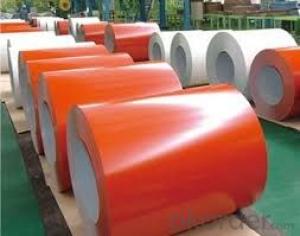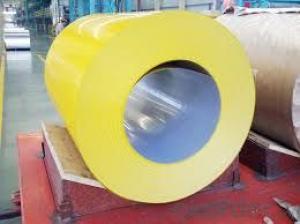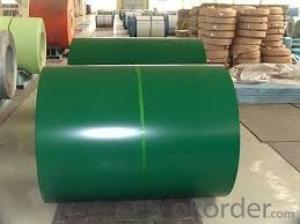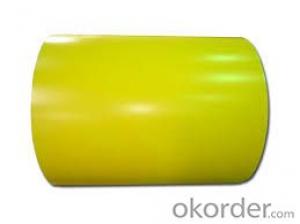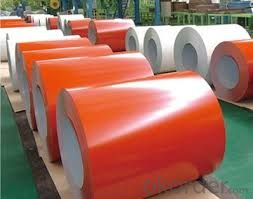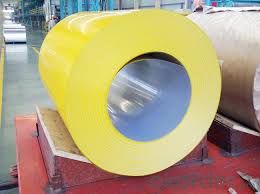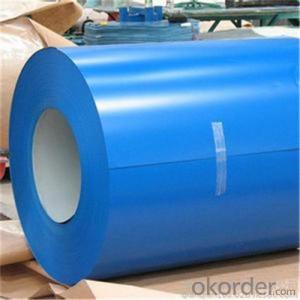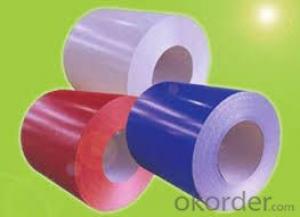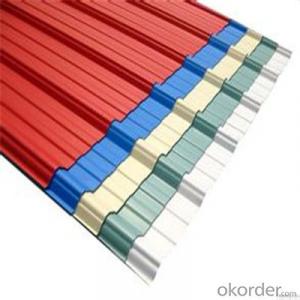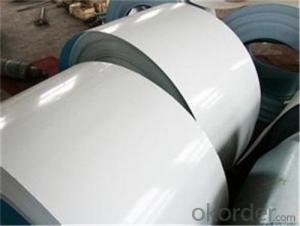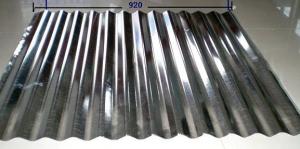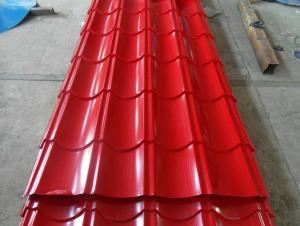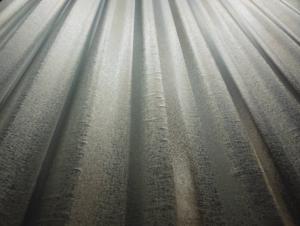Prepainted galvanized corrugated plate / sheet from China
- Loading Port:
- Tianjin
- Payment Terms:
- TT OR LC
- Min Order Qty:
- 100 m.t.
- Supply Capability:
- 500000 m.t./month
OKorder Service Pledge
OKorder Financial Service
You Might Also Like
Brief Introduction of Prepainted Galvanized Steel:
Prepainted Galvanized Steel usually refers to have substrate processed with surface processed and coated then(roller coated )or bonded organic thin film and baked, and it is able to be processed to final production .
Prepainted Galvanized Steel qualified with excellent decorative, formability, corrosion resistance, coating adhesion ,can keep for a long time as well as maintain fresh color .For color coated steel sheet can obtain good economic benefit by steel belt wood ,efficient in construction and save energy ,prevent pollution etc. Which is an ideal material; for manufacturing board.
Description of Prepainted Galvanized Steel:
1.material : galvanized steel sheet / prepainted galvanized sheet
2.sheet thickness : normal use 0.3-0.6mm
3.length: any length, according to the transportation, generally less than 12m
4.color: standard color: red, blue, white, grey; special color: according to RAL color
Specification of Prepainted Galvanized Steel:
prepainted corrugated steel plate | |
material | galvanized steel sheet |
prepainted galvanized sheet | |
model No. | types of roof sheets |
sheet thickness | normal use 0.3-0.6mm |
length | any length, according to the transportation, generally less than 12m |
color | standard color:red, blue, white, grey |
special color: according to RAL color | |
characteristic | 1:weather proof |
2:heating insulation | |
3:fireproof | |
4:anti-rust | |
5:sound insulation | |
6:long life span: more than 15 years | |
advantages | 1.low foundation cost |
2.easy construction | |
3.time saving | |
4.labor saving | |
application field | 1:construction:prefabricated house, steel house, mobile house, modular house, villa, bungalow design, portable house/carbin, ready made house, kiosk booths, steel building... |
2:container manufacturing | |
3:household appliances and furniture | |
4:vehicle and vessel manufacturing | |
5:others,like machinery structual parts, manufacturing shells of motors and so on | |
packing | plastic film, pallet or as your request |
Applications of Prepainted Galvanized Steel
It can be widely used in transportation, light industry, civil usage and farming. It is also the perfect building material in construction for making steel roofing, insulation panel, corrugate sheet, facade wall, shutters, T-bar and home appliance.
Packaging & Delivery of Prepainted Galvanized Steel
The packing of coils consists of anti-damp paper, PVC film, hardboard paper, steel box, strapped with steel strips, fitted with locks and edge protectors and guarantees the optimal condition of the delivered goods. Each coil can be additionally fitted with wooden/steel skids(eye to the side) or wooden pallets(eye to the sky).
Images of Prepainted Galvanized Steel:
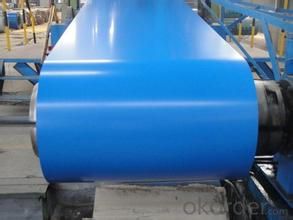

- Q: What is the maximum load-bearing capacity of steel sheets?
- The specific type and thickness of steel sheets can cause the maximum load-bearing capacity to vary. Steel sheets are generally known for their strength and durability, which allows them to handle heavy loads. The load-bearing capacity of steel sheets is typically measured by its yield strength or ultimate tensile strength. Yield strength refers to the maximum stress a steel sheet can handle before permanently deforming, while ultimate tensile strength refers to the maximum stress it can handle before fracturing. The load-bearing capacity of steel sheets can range from a few hundred pounds to several thousand pounds per square inch (psi). For instance, mild steel sheets usually have a yield strength of approximately 50,000 psi, enabling them to support moderate loads. Conversely, high-strength steel sheets can have a yield strength of over 100,000 psi, allowing them to withstand heavy loads. It's important to consider that the load-bearing capacity of steel sheets can also be affected by factors such as dimensions, surface condition, and support method. Moreover, engineers and structural designers often take safety margins and the factor of safety into account when determining the maximum load-bearing capacity of steel sheets for specific applications. Therefore, it is advisable to consult relevant engineering standards, specifications, or professionals for accurate load-bearing capacity information in a particular context.
- Q: What is the difference between a satin and mirror finish steel sheet?
- The appearance and level of reflectivity distinguish a satin finish steel sheet from a mirror finish steel sheet. A satin finish steel sheet displays a sleek, non-glossy appearance with a minimal level of reflectivity. Achieved through the use of abrasive materials, it creates a brushed or textured surface. This finish is often favored for its contemporary and subtle aesthetic. Satin finish steel sheets find common usage in architectural and interior design applications, such as kitchen appliances, countertops, and wall panels. On the contrary, a mirror finish steel sheet exhibits an immensely reflective surface that closely resembles a mirror. Achieved by polishing the steel sheet to a high gloss using fine abrasives and buffing compounds, this finish boasts an intense shine and exceptional clarity. It reflects light remarkably, resulting in a glamorous and opulent appearance. Mirror finish steel sheets are commonly employed in decorative applications, including automotive trim, jewelry, and ornamental architectural elements. To summarize, the primary distinction between a satin and mirror finish steel sheet resides in their appearance and level of reflectivity. Satin finish offers a smooth, matte appearance with minimal reflectivity, while mirror finish provides an incredibly reflective, mirror-like surface.
- Q: Do steel sheets have any environmental benefits?
- Yes, steel sheets have several environmental benefits. Firstly, steel is highly recyclable, meaning that it can be reused multiple times without losing its strength or quality. This reduces the need for virgin raw materials and reduces the amount of waste being sent to landfills. Additionally, steel production has become more energy-efficient, resulting in lower greenhouse gas emissions compared to other materials. Steel sheets are also highly durable and resistant to corrosion, which means they have a longer lifespan and require less maintenance, reducing the overall environmental impact.
- Q: What are the standard dimensions for steel sheets?
- The standard dimensions for steel sheets can vary depending on the specific type and grade of steel being used. However, in general, steel sheets typically come in standard sizes of 4 feet by 8 feet or 4 feet by 10 feet. These dimensions are commonly used in the construction industry and are readily available from steel suppliers. Additionally, steel sheets can also be custom cut to specific dimensions as per the requirements of a particular project. It is important to consult with a steel supplier or manufacturer to determine the exact dimensions available for the specific type of steel sheet needed.
- Q: What are the different manufacturing processes for steel sheets?
- There are several manufacturing processes for steel sheets, including hot rolling, cold rolling, and electro-galvanizing. Hot rolling involves heating the steel above its recrystallization temperature and then passing it through rollers to achieve the desired thickness and shape. Cold rolling, on the other hand, involves passing the steel through rollers at room temperature to further refine its thickness and surface finish. Electro-galvanizing is a process where a layer of zinc is electroplated onto the steel sheet to provide corrosion resistance. Other processes such as pickling, annealing, and coating may also be involved in the manufacturing of steel sheets.
- Q: How do steel sheets perform in terms of sound insulation?
- Steel sheets have poor sound insulation properties compared to other materials such as wood or gypsum. They do not effectively block or absorb sound waves, resulting in minimal reduction of noise transmission.
- Q: What is the difference between a galvanized and stainless steel sheet?
- Both galvanized and stainless steel sheets are utilized in various applications, but there are notable distinctions between the two materials. One significant difference is their resistance to corrosion. Galvanized steel sheets are coated with zinc to shield them from rust and corrosion, making them ideal for outdoor applications or environments with high humidity or moisture. Conversely, stainless steel sheets are composed of chromium and other alloys, granting them superior corrosion resistance. They can endure exposure to chemicals, acids, and saltwater, making them suitable for highly corrosive environments. Another disparity lies in their appearance. Galvanized steel sheets possess a characteristic silver-gray color due to the zinc coating. Over time, the zinc coating can acquire a dull, weathered appearance. In contrast, stainless steel sheets possess a distinct, shiny appearance that can vary based on the applied finish. This makes stainless steel sheets more visually appealing and suitable for applications where aesthetics matter. In terms of strength and durability, stainless steel sheets tend to surpass galvanized steel sheets. Stainless steel has a higher tensile strength, enabling it to withstand more force or pressure before breaking. Additionally, stainless steel is more resistant to dents and scratches compared to galvanized steel. Cost is another factor to consider when choosing between galvanized and stainless steel sheets. Generally, galvanized steel sheets are more cost-effective than stainless steel sheets. This makes them a viable option for applications where corrosion resistance is not of utmost importance. Conversely, stainless steel sheets are pricier due to the higher cost of raw materials and the additional processing required to create the stainless steel alloy. To summarize, the main distinctions between galvanized and stainless steel sheets lie in their corrosion resistance, appearance, strength, and cost. Galvanized steel sheets offer decent corrosion resistance at a lower cost, while stainless steel sheets provide superior corrosion resistance, strength, and a more appealing appearance at a higher price point.
- Q: How do steel sheets compare to wood sheets?
- Steel sheets and wood sheets differ significantly in terms of strength, durability, and usage. To begin with, steel sheets are renowned for their remarkable strength and durability. They can endure heavy loads, extreme weather conditions, and possess high resistance to warping, rotting, and insect damage. Conversely, wood sheets are less sturdy and may succumb to moisture, termites, and decay if not adequately treated or maintained. Regarding versatility, steel sheets offer a wide array of applications. Their high tensile strength and structural stability make them commonly utilized in the construction, automotive, and manufacturing industries. Conversely, wood sheets are commonly employed in interior design, furniture production, and smaller-scale construction projects due to their natural aesthetic appeal and ease of manipulation. Furthermore, steel sheets are fire-resistant, making them a safer option compared to wood sheets, which are combustible and can contribute to the spread of fire. Steel sheets also boast a longer lifespan, necessitating less maintenance and replacement compared to wood sheets, which may require regular refinishing, sealing, or replacement due to wear and tear. Nevertheless, wood sheets possess their own advantages. They are generally more cost-effective than steel sheets, making them a popular choice for projects with budget constraints. Additionally, wood sheets have superior insulation properties, providing natural warmth and soundproofing qualities. Ultimately, the selection between steel sheets and wood sheets hinges on the specific project requirements, encompassing factors such as budget, desired aesthetics, structural needs, and environmental considerations.
- Q: Can steel sheets be used for electromagnetic shielding?
- Yes, steel sheets can be used for electromagnetic shielding. The high electrical conductivity of steel allows it to effectively redirect or absorb electromagnetic waves, thus providing protection against electromagnetic interference.
- Q: How are steel sheets made?
- Steel sheets are typically made through a process called hot rolling, where steel is heated until it becomes malleable and then passed through a series of rollers to reduce its thickness and shape it into a sheet form.
Send your message to us
Prepainted galvanized corrugated plate / sheet from China
- Loading Port:
- Tianjin
- Payment Terms:
- TT OR LC
- Min Order Qty:
- 100 m.t.
- Supply Capability:
- 500000 m.t./month
OKorder Service Pledge
OKorder Financial Service
Similar products
Hot products
Hot Searches
Related keywords
